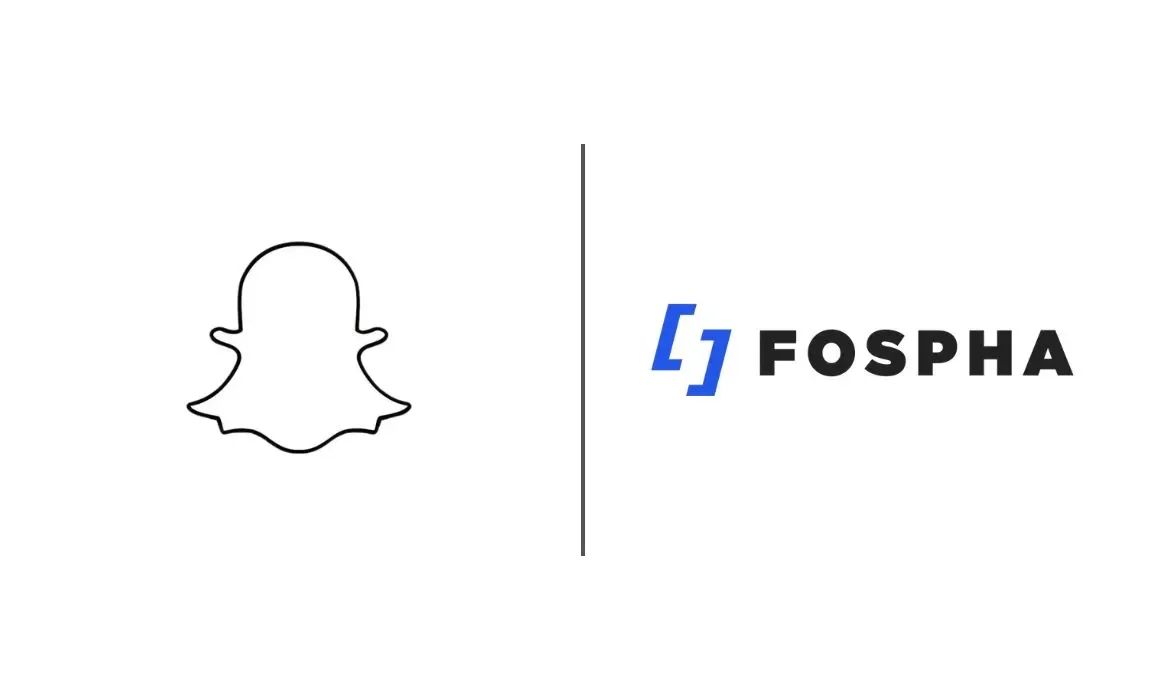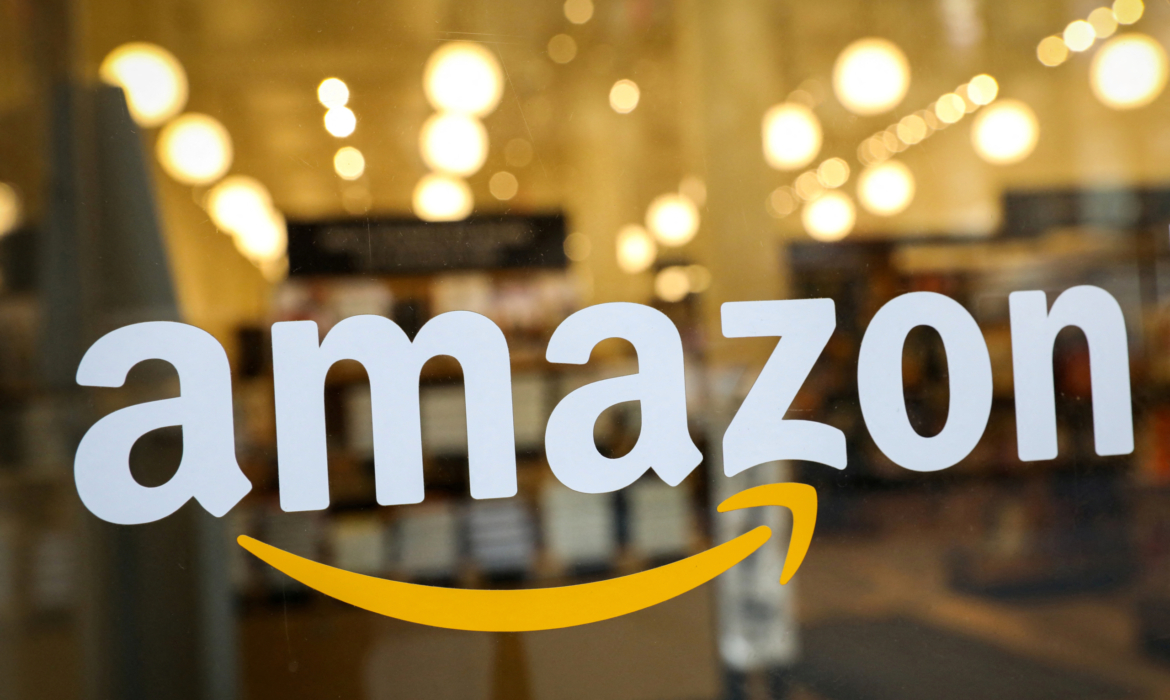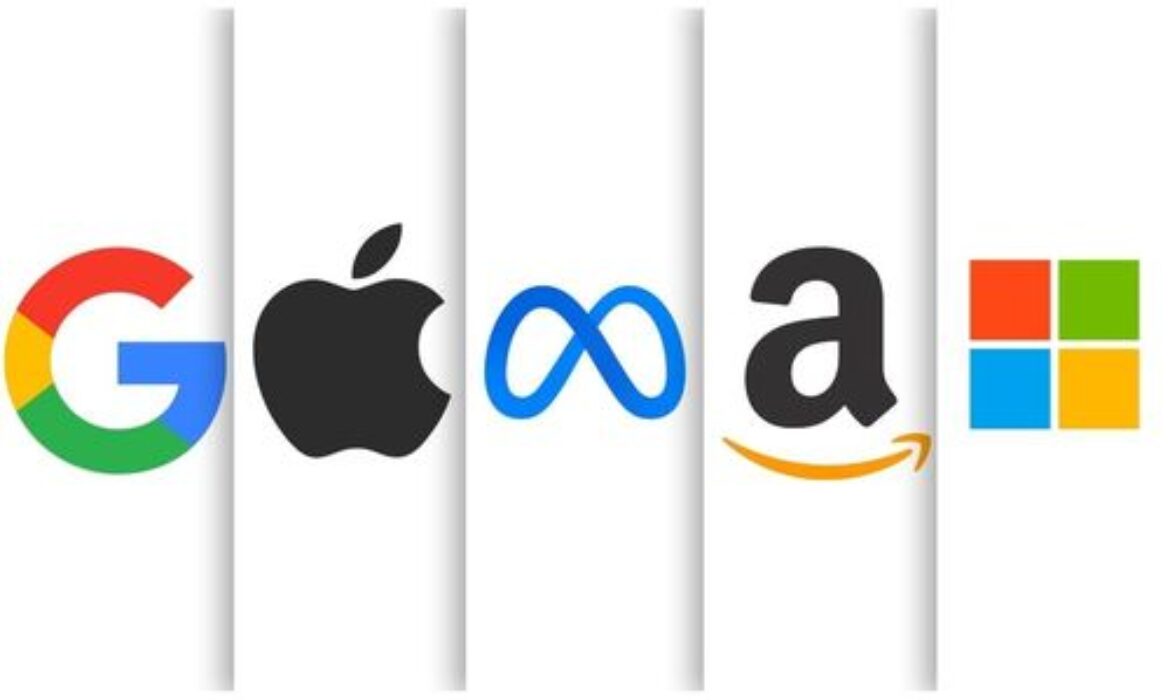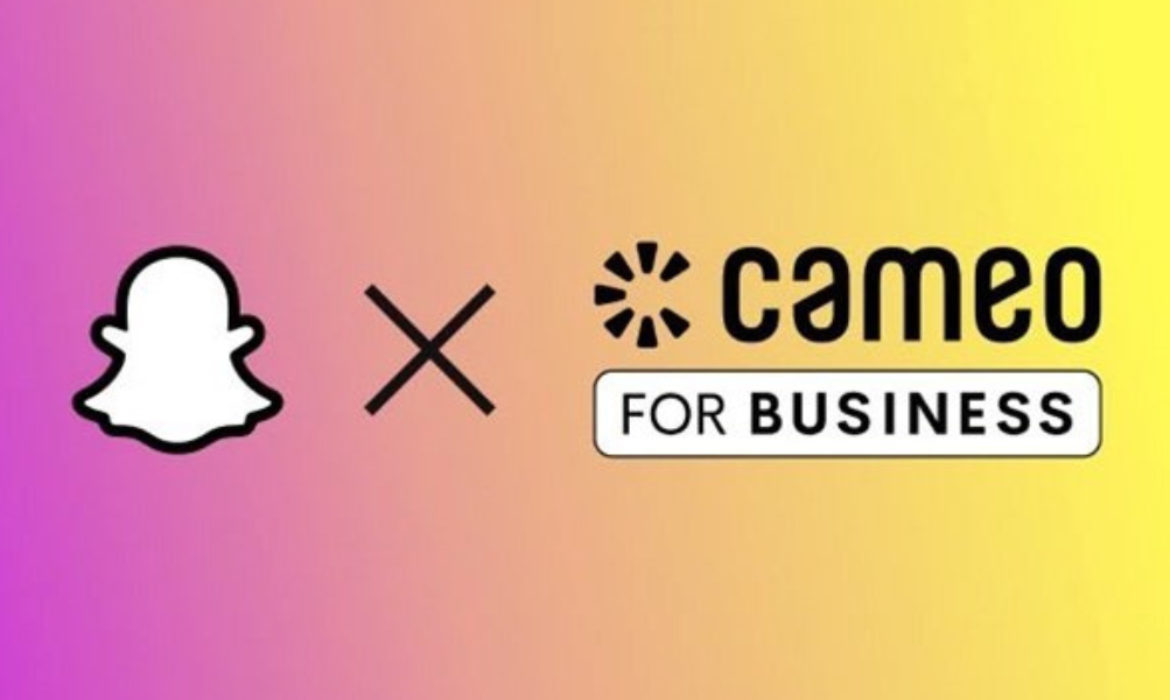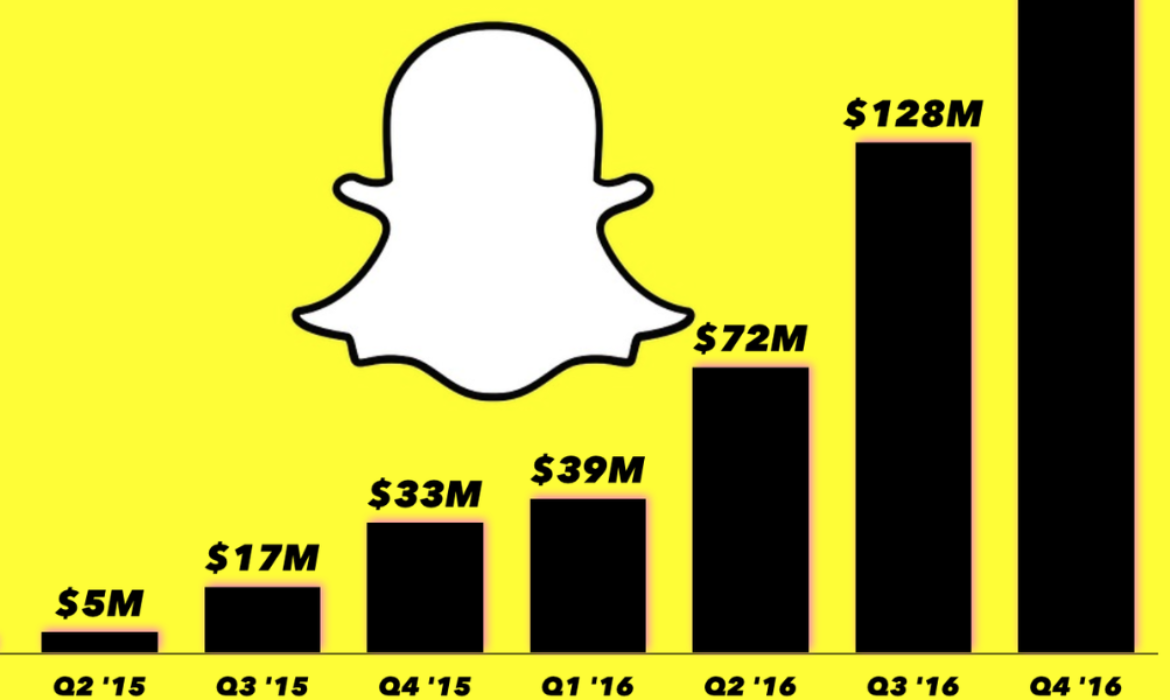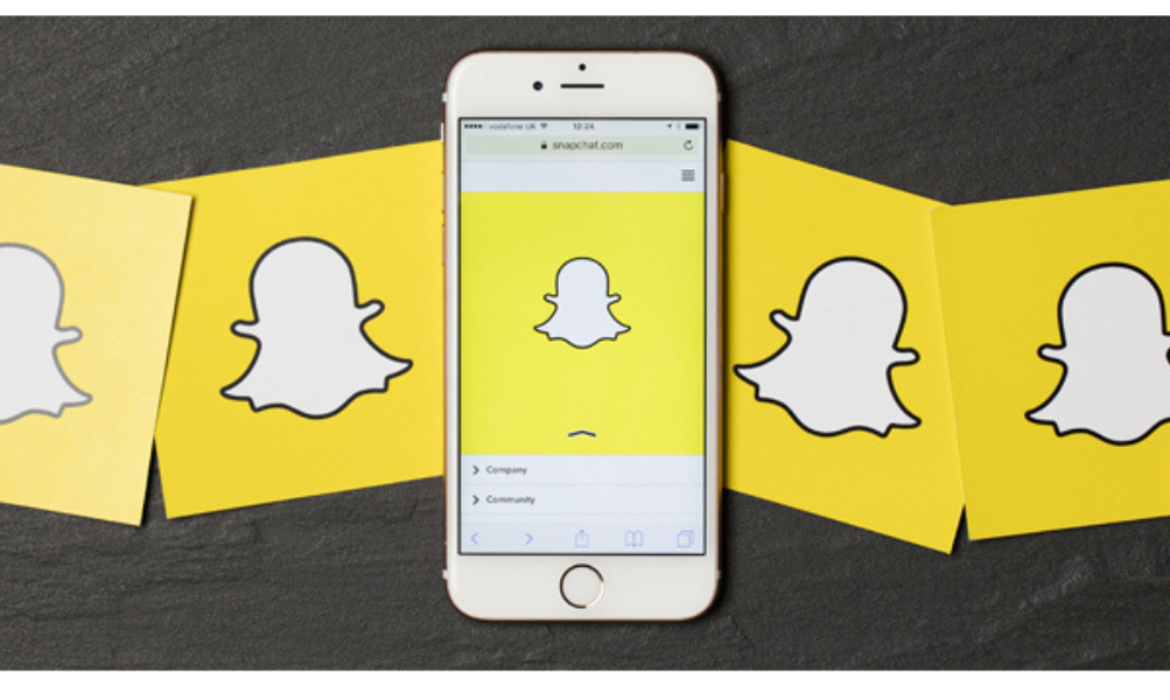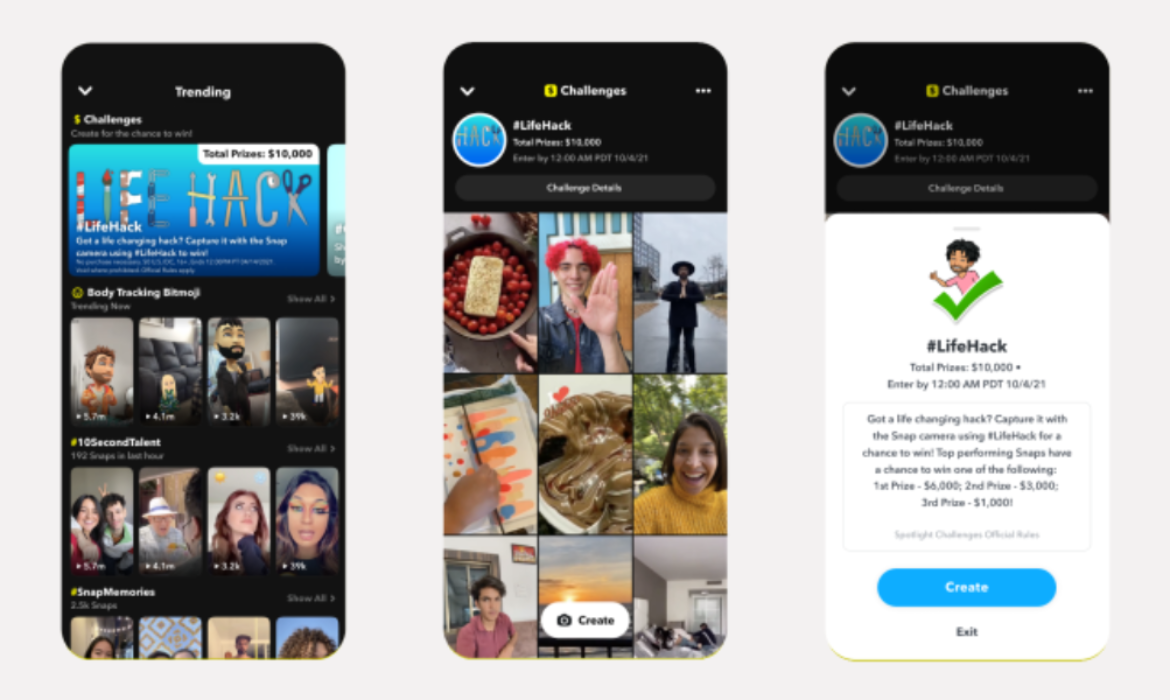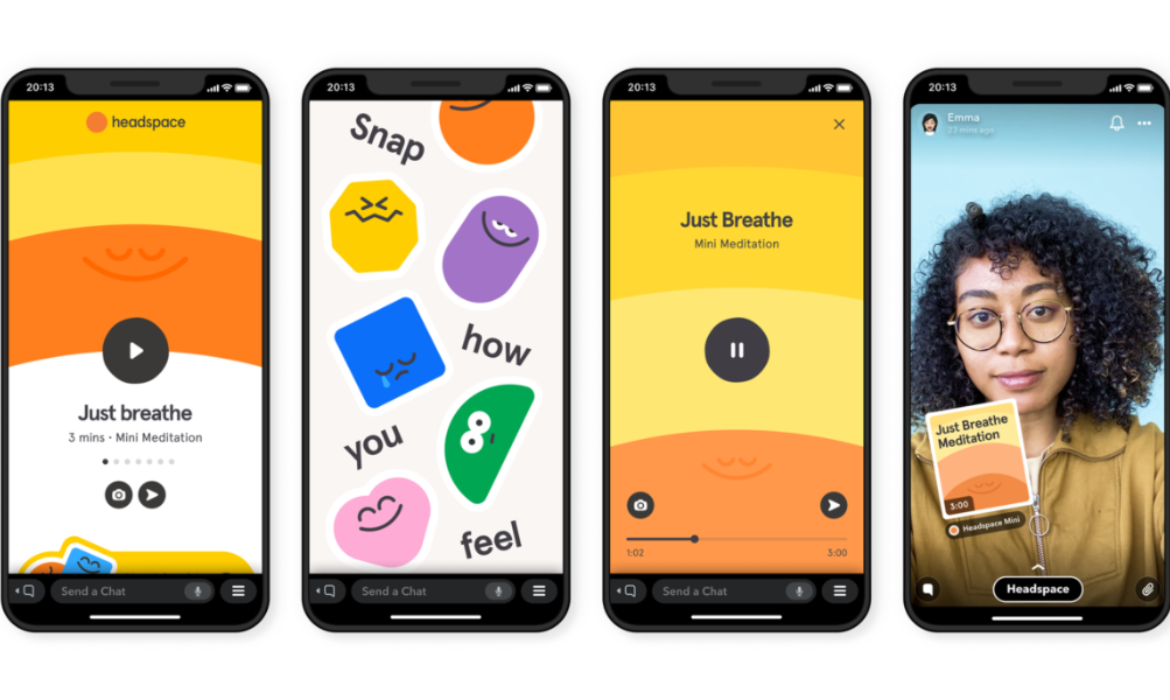Snapchat and Fospha Partner for Enhanced Snapchat Campaigns Insights
Snapchat and Fospha, a pioneer in marketing analytics and measurement, have announced a new collaboration. The partnership seeks to provide advertisers with more insightful campaign data. Additionally, the partnership aims to give eCommerce advertisers a more comprehensive tracking and efficacious way to enhance the performance of their Snapchat campaigns, with a specific focus on cross-marketing return on ad spend (ROAS). Advertisers will be able to assess the overall performance of their campaigns with greater accuracy by directly comparing their Snapchat results to those of other channels, such as Search.
Snapchat and Fospha partner for enhanced insights on Snapchat campaigns
With this partnership, Snapchat is taking a significant step toward proving to eCommerce companies the worth of its advertising platform. Advertisers can now more clearly see how their Snapchat campaigns affect financial performance and confidently scale their investments for even greater success thanks to Fospha’s sophisticated measurement tools.
Why choose Fospha?
Fospha is leading the way with a revolutionary new method of measuring cross-channel digital marketing. Clients can go live in two to three weeks with a full year of funnel performance (impressions, clicks, zero-party data) modeled and completely private (no user-level personal data is used) thanks to a no-code implementation.
Fospha uses a combination of Media Mix Modelling (MMM) and Multi-Touch Attribution (MTA) to examine how different marketing touchpoints affect a customer’s journey. This enables marketers to learn more about the impact of Snapchat ads on conversions, even in situations where users engage with other platforms before completing a transaction. Fospha also discovered that brands without investment in higher funnel activity, such as Snapchat, have much higher acquisition costs and lower returns on ad spend across its clientele.
Read More: mFilterIt Announces Rebranding Initiative, Reveals New Brand Identity
What issue does the partnership aim to resolve?
It has always been difficult to gauge the real impact of impression-led advertising, and recent privacy regulations have made it even more difficult to obtain the necessary data. According to a 2023 study by Fospha, basic click-tracking techniques like last click and MTA miss roughly 74% of sales that originate from impression-based media. This indicates that basic click-tracking methods do not adequately account for the value of upper-funnel activity. Fospha also discovered that brands that do not engage in higher-funnel activities, such as Snapchat, have much higher acquisition costs and lower returns on advertising spend.
Fospha reports
The announcement follows the release of the most recent report from Fospha, which showed that Snapchat ads are becoming more successful for e-commerce companies. Ad spending on the platform increased by 76% year over year, but ROAS for Fospha clients using Snapchat increased by an astounding 504% between 2022 and 2023, according to the report. The study also showed that companies with lower overall return on ad spend and higher customer acquisition costs on platforms like Snapchat neglected to engage in higher funnel marketing activities.
Here’s what they said
Snapchat in its statement said,
“With this partnership, Fospha and Snap will help marketers increase their confidence in spending on Snapchat and enable them to capitalize on strong campaign performance at higher spend levels.”
Read More: Havas Announces Acquisition of Ledger Bennett, A UK-Based B2B Marketing Agency
After Meta, E-commerce Giant Amazon Taps Snapchat For In-App Shopping Feature
Amazon announced that it will enable Snapchat users in the U.S. to make direct purchases from the social media platform for select Amazon products. Customers will be able to shop straight from Amazon ads for Snapchat and check out without ever leaving the app thanks to the partnership. The move is part of the e-commerce giant’s strategy to profit from the rising popularity of social media shopping.
Rise of social media influence on e-commerce firms
Some platforms, like TikTok, are launching their own online shopping services as a result of social networks’ growing influence on shopping trends and patterns. Conversely, e-commerce companies can access the subscriber base through other social media platforms such as Snapchat.
Benefits to Snapchat from the e-commerce integration
Snap, which has reported higher-than-expected revenue and user growth over the last three months, would benefit from the deal. Additionally, the data shows that marketers are reverting to using smaller platforms like Snapchat.
Read More: Amazon Announces Publisher Cloud to Plan Programmatic Deals in Amazon DSP
Amazon – Snapchat partnership
On some Amazon products, prospective customers will also be able to view real-time pricing, Prime eligibility, delivery estimates, and product details on Snapchat. It comes after the e-commerce behemoth’s agreement with Meta, which permits users of the online retailer to link their Facebook and Instagram accounts to Amazon and make purchases straight from the social media platforms. Amazon and Pinterest have a similar partnership. The collaboration might facilitate Snap’s advertising business’s comeback.
Here’s what they said
Amazon spokesperson said in a statement,
Customers in the U.S. will see real-time pricing, Prime eligibility, delivery estimates, and product details on select Amazon product ads in Snapchat as part of the new experience. In-app shopping with Amazon is available for select products advertised on Snapchat and sold by Amazon or by independent sellers in Amazon’s store.
Read More: Meta and Amazon Collaborate for In-App Shopping in FB and IG
Snapchat Introduces Screen Sharing Feature For its Web Users
With the inclusion of screen sharing, Snapchat, the multi-media messaging software has made a big advancement in its technological capabilities. The platform is historically only known for its messages that vanished. On the web version of its platform, the company has launched a new feature that enables users to screen share during calls. Snapchat had previously concentrated on image-based communication and brief video. It appears that the platform is attempting to expand its functionality with screen sharing, perhaps with an eye toward the industry that is now dominated by Zoom and Microsoft Teams.
Benefits of Screen Sharing on Snapchat
Convenient communication
The simplicity of screen sharing on Snapchat is one of its advantages. As they can see everything in real time, there is no need to provide screenshots or videos of what you want to communicate with someone. When demonstrating a new program or game or teaching a hard concept, this can be helpful. Utilizing this tool, nevertheless, requires caution since it raises potential privacy issues.
Sharing a screen facilitates more efficient conversation. It can be difficult to successfully communicate some concepts when all that can be done through texting is transmit text messages or, at most, photos. However, one may quickly convey an idea graphically or tell the other person how something works through screen sharing.
Problem-solving
Second, screen sharing facilitates learning and problem-solving. It’s especially helpful when attempting to solve computer-related issues, such as diagnosing software problems or instructing someone on how to properly utilize a specific program.
Collaboration
Last but not least, employing Snapchat’s screen-sharing feature encourages interaction among team members who are digitally working together across multiple locations at the same time, making life easier for everyone concerned.
In conclusion, Snapchat’s screen-sharing function offers a variety of advantages that enhance communication effectiveness and foster deeper interpersonal engagement.
Screen Sharing with Snapchat
Screen sharing has long been a standard feature of business-oriented digital communication tools. It is now also accessible for private use on social media sites like Snapchat.
How to share a Snapchat online screen
- Users must sign into their Snapchat account via the mobile app or the website at web.snapchat.com in order to enjoy the new screen-sharing feature.
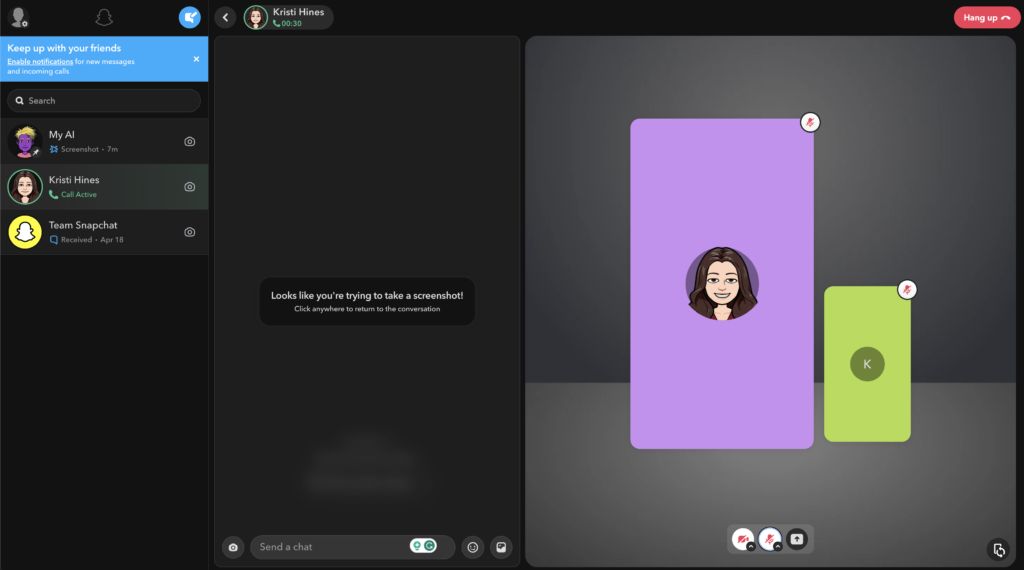
Image credit- Search Engine Journal
- The next step is to start a call with a friend or a group after logging in.
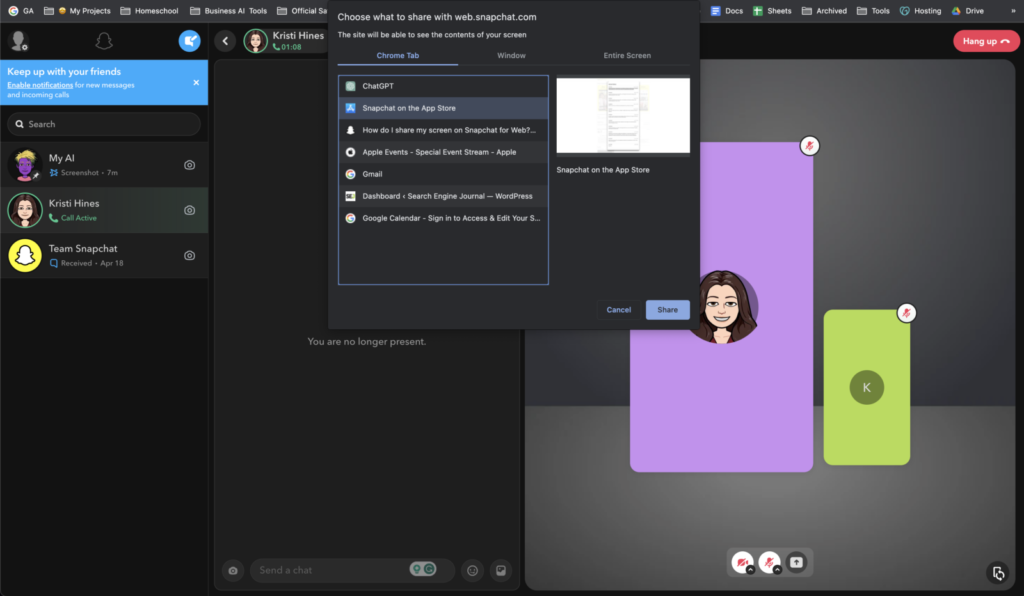
Image credit- Search Engine Journal
- The share button is located at the bottom of the screen near the video and microphone controls. Users may share their screen by clicking it.
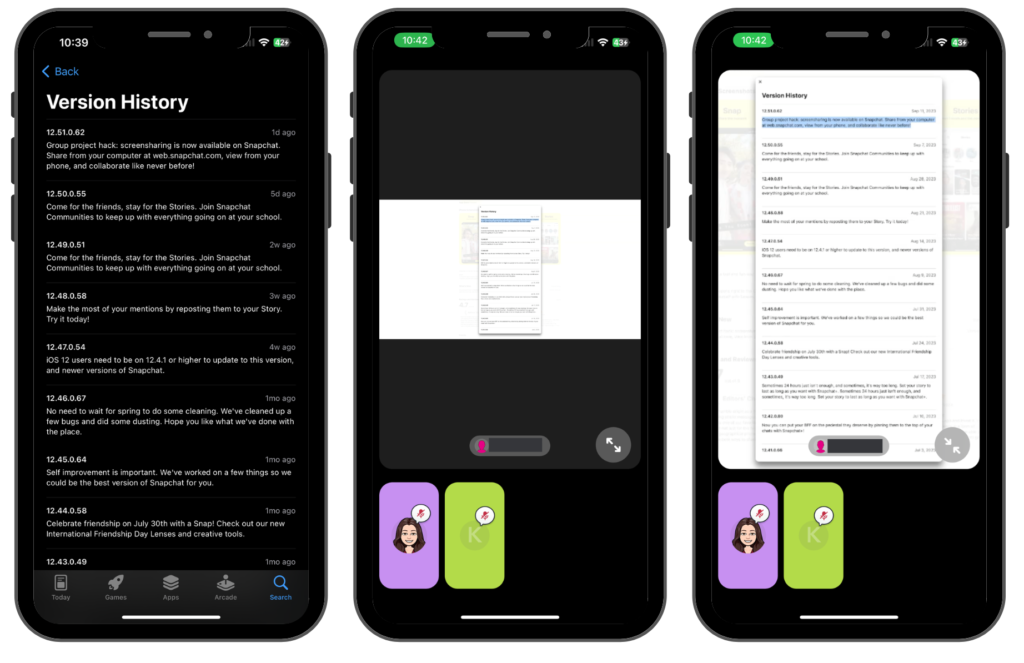
Image credit- Search Engine Journal
- Users can collaborate more fluidly online by sharing from their PCs and seeing from their phones.
Users can share their screen with other Snapchat users when using the iPhone app. However, users must be using the online interface.
The most recent changes for Snap users
The function may alter how common users collaborate online. Whether it be students working on group projects or families attending online activities. Businesses and marketers may also use Snapchat in novel ways to connect with target clients on the well-liked site. Overall, it’s evident that Snapchat always aspires to enhance its user experience through the introduction of creative updates designed to raise the caliber of our online discussions while integrating some entertaining components into it. This social media platform is one to keep an eye on because of its enhanced screen-sharing capabilities, which create limitless opportunities for interaction among friends across diverse geographic areas and give users access to a large variety of third-party programs via Mini-apps.
Read More: Lemon8, TikTok’s sister app struggles in the US, users cite inorganic feel and influencer bias
Delve In What the Quarterly Results For Big Tech Titans Are Saying
The quarterly results for big tech companies are out. Here are some key takeaways for advertisers and marketers.
Microsoft
Microsoft’s fiscal year has been challenging on many fronts. The acquisition of Xandr, the ad-buying platform, and the increase in search volume revenues failed to produce satisfactory results, making Microsoft miss the mark in Q4. With continuous commitments to investing in artificial intelligence technologies, analysts predicted the quarter to be successful for Microsoft. The company attributed stagnant growth to a decline in advertising spending, which was lower than a quarter on quarter.
Its Talent Solutions contributed to the company’s revenue growth exceeding expectations. Despite the increased revenue, Microsoft reported a reduction in numbers due to low ad spending. The tech giant concluded it was due to marketing solutions decline. LinkedIn’s revenue increased due to growth in Talent solutions. Microsoft Cloud showed promising growth in all of its businesses with improvements in its verticals. Search and news advertising went up with the Xandr acquisition.
By the numbers:
- Revenue was up by 8% increasing to $56.2 billion.
- Advertising and news search revenues up to $86 million, a 3% increase including traffic acquisition cost, 8% increase excluding traffic acquisition cost.
- Azure Cloud revenue growth slowed from 27% to 26%.
- LinkedIn revenue increased by 5%.
- Microsoft Cloud’s quarterly revenue was 21% or $30.3 billion YoY.
Currently, the company is prioritizing developing and spearheading safe generative AI models and practices. Their aim is to help customers use Microsoft Cloud to make the most of their digital resources and drive operations control.
Satya Nadella, Chairman and Chief Executive Officer, Microsoft stated in the Q4 results announcement,
We remain focused on leading the new AI platform shift, helping customers use the Microsoft Cloud to get the most value out of their digital spend, and driving operating leverage.
Amy Hood, Executive Vice President and Chief Financial Officer at Microsoft cited,
Advertising spend was slightly lower than anticipated which impacted Search and News advertising and LinkedIn Marketing Solutions. For LinkedIn, we expect revenue growth in the low to mid-single digits.
She further added,
Even with share gains in our hiring business, growth will continue to be impacted by the overall markets for recruiting and advertising, especially in the technology industry where we have significant exposure.
Meta
Meta produced results in Q2 that exceeded analysts’ expectations. Revenues from advertising rose robustly. The revenue uptick signaled the social giant’s ad business recovery after previous years of gloom and cross-border concerns. Meta cited the increase in DAUs for Reels, the company’s short-form video content app. This attracts 200 billion people to Facebook and Instagram. The app also generated $10 billion annually, which is a $3 billion increase Q/Q.
The company credits the increase in ad revenues to Threads, the text-based app, and continued investment in artificial intelligence. The company ascribed the increase in ad impressions to a heightened focus on TikTok’s rival Reels and AI-driven products as the key factors in the positive outcome. Meta commits to AI advancements and data centers. The CEO has also highlighted AI as the focal point of Meta’s growth strategy. He predicts revenue from AI-powered structures for marketers, AI chat agents, and productivity tools for employees.
By the numbers:
- Revenue up to $32 billion, up 11%.
- Facebook DAUs are 2.06 billion on average, an increase of 5% year over year.
- Facebook’s MAUs of 3.03 billion increased by 3% year-over-year.
- Family daily active people (DAP) 3.07 billion on average, 7% up Yo-Y.
- Family monthly active people (MAP) 3.88 billion and 6% higher Yo-Y.
- Ad impressions in Q2 2023 increased 34% year-over-year and the average price per ad decreased 16% Yo-Y.
Susan Li, Meta’s Chief Financial Officer however stated that their ongoing commitment to invest in Reality Labs, Meta’s unit for metaverse-related initiatives negatively impacted their results. However, it will not hamper their ambition to spearhead metaverse developments.
Mark Zuckerberg, CEO of Meta added,
We had a good quarter. We continue to see strong engagement across our apps and we have the most exciting roadmap I’ve seen in a while with Llama 2, Threads, Reels, new AI products in pipeline, and the launch of Quest 3 this fall.
Alphabet
Alphabet, Google’s parent company overcame its advertising slump in the Q/Q, signaling a return to momentum with favorable results. The revival of their revenue graph was needed to reshape the competitive AI technology landscape. The Q2 results erased concerns about Google losing digital ad prowess to AI advancements on the financial forefront.
The company attributed the overall growth to increasing Google Cloud Services demand, which is anticipated to adopt AI as it advances. The rise in revenues can be traced to costs from YouTube subscriptions and the Pixel family’s content acquisition. YouTube witnessed a surge in stabilized ad spending despite competition from TikTok. Google Cloud revenues were up due to its AI-optimized structure which piqued consumer interest.
By the numbers:
- Revenue was $74.6 billion, up 7%.
- Ad sales rose 3% to $58.1 billion.
- YouTube revenues increased by 4% to $77 billion driven by brand advertising.
- Network advertising revenues were down 5% at $7.9 billion.
- Google Search and other advertising revenues were up 5%, to $42.6 billion.
- Google Cloud revenues are up 28%, at $23.5 billion.
Alphabet is certain that the money needed to finance AI advancements will come from Google’s advertising engine. As such, Google has predicted that it will face more difficulties not only from rivals like ChatGPT, Microsoft, and Bing but also from Amazon’s shopping unit and TikTok and Reddit in trending topics. As part of its efforts to strengthen cybersecurity capabilities, search, and advertising capabilities, the CEO mentioned that AI would be integrated across its product groups.
Sundar Pichai, CEO, said in the announcement,
There’s exciting momentum across our products and the company, which drove strong results this quarter. Our continued leadership in AI and our excellence in engineering and innovation are driving the next evolution of Search and improving all our services.
CFO Ruth Porat commented,
We expect elevated levels of investment in our technical infrastructure, increasing through 2023 and continuing in 2024. The primary driver is to support AI opportunities across Alphabet, including investments in GPUs and proprietary TPUs, as well as data center capacity. With all that said, we remain committed to durably re-engineering our cost base to help create capacity for these investments in support of long-term, sustainable financial value.
Amazon
Amazon released its second-quarter earnings, and the numbers were impressive. According to CEO Andy Jassy, Amazon saw developments in areas they had been steadily advancing in for the past quarters. The e-commerce giant attributes its revenue growth to the rise in price points, selections, and convenience available to its consumers. Amazon continues to see strong demand for everyday essentials, positive feedback from customers, and updates to its website, mobile apps, and customizations.
AWS growth stabilized in Q2. Moreover, it continues to grow with customers, partner networks, functionality, and operational presentation. AWS revenues were twice as high as any other provider. Amazon is constantly working to further AWS technologies and features to aid customers in leveraging generative AI, productivity, and security. Ad revenue increased due to performance-based advertising efforts, improved customer relevance of ads, and ML benefits to understand ROI and ad spending for brands.
By the numbers:
- $134.4 billion revenue, an increase of 11% Y-o-Y vs estimates of $131.5 billion by Refinitiv analysts.
- Advertising revenue is up 22% Yo-o-Y, to $10.68 billion.
- AWS sales revenue growth of 12% Yo-Y to $22.1 billion.
- Subscription service revenues including Prime memberships were up 14%, at $9.8 billion.
Amazon is currently working on enhancing Machine Learning models to help marketers access audiences that were difficult to reach with Amazon ads. During an AWS event in New York, Amazon also committed to enhancing generative AI-powered applications with the latest and improved pre-trained large language models (LLMs).
CEO Andy Jassy mentioned in the earnings call,
As the economy has been uncertain over the last year, AWS customers have needed assistance cost optimizing to withstand this challenging time. They have also needed assistance reallocating spending to new initiatives that better drive growth. We’ve proactively helped customers do this.
Apple
Apple reported their results for the third quarter that were better than their expectations, however, revenue was down Yo-Y. The company attributed the growth in its revenue to healthy iPhone sales across the world. Apple set an all-time high record for services revenues, including advertising, the app store, and music, exceeding its predictions. The slump in iPad sales revenue was accredited to the iPad Air launch in the prior year. They continue to invest in product enhancements to encourage customer satisfaction which was reported to be 98% across the U.S.
By the numbers:
- Revenue was $81.8 billion, down 1% Yo-Y.
- iPhone revenues are $39.7 down 2% Y-o-Y.
- $6.8 billion, down 7%, for Mac.
- iPad $5.6 billion, down 20%.
- Wearables home, and accessories revenues were $8.3 billion up 2% with expectations.
- Services revenue $21.2 acceleration of 8%.
Apple is releasing its most ambitious and advanced personal electronic device, the Apple Vision Pro early next year for ordinary consumers. It is currently only available to advertisers, content creators, etc for demo purposes and has received stellar reviews.
AI and machine learning will continue to be an integral part of product design. Apple is planning to introduce AI and ML-powered live voicemail in iOS 17. They have also invested in research into generative AI and continue to responsibly enhance their products with these technologies. This is with the goal of enriching people’s lives.
Tim Cook, Apple’s CEO said,
We are happy to report that we had an all-time revenue record in Services during the June quarter, driven by over 1 billion paid subscriptions, and we saw continued strength in emerging markets thanks to robust sales of iPhone. From education to the environment, we are continuing to advance our values, while championing innovation that enriches the lives of our customers and leaves the world better than we found it.
Luca Maestri, Apple’s CFO, further remarked,
Our June quarter year-over-year business performance improved from the March quarter, and our installed base of active devices reached an all-time high in every geographic segment.
Snapchat.INC
Snapchat reported its quarterly results and they were mixed. Although revenue was up Q/Q, it still saw a Yo-Y dip. Just like its competitors, Snapchat is grappling with a slump in advertising revenues. Snapchat also introduced an exciting and innovative AI feature a few months back to keep the platform happening and engaged. My AI, Snapchat’s AI chatbot is now integrated into group chats, recommendations, and ‘Lens’ suggestions.
By the numbers:
- Revenue was $1,068 million compared to $1,111 million the previous year
- DAUs 397 million, an increase of 50 million or 14% Yo-Y
- 4 million global users for paid subscriptions introduced in the previous year
This quarter, the social media company pledged to improve advertisers’ expectations through machine learning technology. It will do so to upgrade its framework, find creative approaches to measuring and optimizing ad spending, and encourage new leadership. Its continuous investment in ML infrastructure has improved company ranking and content personalization.
Snapchat believes that it will face healthy community growth in the next quarter with expected DAU increases of 405 to 406 million.
Evan Spiegel, Snapchat’s CEO said,
We are excited by the progress we have made delivering increased return on investment for our advertising partners, growing our community to 397 million daily active users, and reaching more than 4 million Snapchat+ subscribers.
Omnicom Media Group
Omnicom Media Group ended its second quarter of 2023 on a high note. The organic growth rate was up 3.4% compared to the previous quarter’s results, placing it within its projected range. Omnicom spearheads generative AI developments in the media business. Their ongoing strategic alliances with companies like Adobe, AWS (Amazon Web Services), and Microsoft help them do this.
The business has also promised to invest in media sales capabilities, environmentally friendly technology, and data from first parties. They are currently realigning their staff to match strategy choices and outlook.
By the numbers:
- 3.4% organic revenue growth in Q2 23, with $3,609.9 million revenue
- Advertising Media revenue growth was 4.2%, while organic growth grew by 5.1%
- Third-party costs which include supplier costs the company incurs when providing services to clients increased to $86.8 million
- Organic growth rate for Public Relations was up 0.1%, while execution & support decreased by 3.8%
John Wren, Chairman and CEO of Omnicom said in the announcement,
While the balance of the year will continue to see economic uncertainty, we are entering a dynamic and exciting new era for our company. Omnicom has secure leading positions in generative AI technologies and partnerships to deliver on our promise to achieve the best outcome for our clients and increase the operational efficiency of our company.
eBay
EBay has exceeded Wall Street’s expectations in all key metrics and delivered positive results. However, the marketplace’s weakened momentum among active buyers was worrying. Gross merchandise sales decreased also recorded.
In spite of this, the e-commerce marketplace believes that its increasing focus on AI integration into its platform will drive further user momentum. The company currently prioritizes laying a strong foundation for generative AI tools across the website to aid marketers and product listers.
By the numbers:
- Revenue was up to $2.51 billion, an increase of 5% from the previous year
- Advertising revenues were $367 million, up 33.5% Yo-Y.
- Promoted Listings revenue was up 47%, reporting $341 million
- The active buyer base declined by 4%
In the next five years, eBay plans to implement AI enhancements in every part of its organization. They are constantly integrating generative AI features into their site. They are also working towards reinventing the e-commerce landscape. Its work has already produced stellar results and hopes to deliver long-term results.
Jamie Iannone, CEO said,
The foundational work we’ve accomplished over the past 3 years has set us up for a new phase of innovation. Our teams are focused on thinking bigger and moving faster as we build game-changing features and functionality for customers to keep eBay at the forefront of eCommerce.
Read More: Advertise Your Brand in the Metaverse: The Future of Digital Advertising
Snap Partners With Cameo, Introduces Advertiser Program
Snap opened its NewFronts this week with the announcement of a new advertiser program and content initiatives – including a new partnership with celebrity video platform Cameo, a new advertising product called Snap Promote, and original programming.
Interesting Read: AVOD strategy For Netflix Ahead: Should Advertisers Rejoice?
Details
The ‘Snap x Cameo Advertiser Program’ will enable Snap advertisers to pay Cameo members to create short video ads for their Snap marketing campaigns. There are more than 45,000 personalities on Cameo, including actors, influencers, musicians, athletes, and more. With this partnership, advertisers will be able to directly reach Cameo’s celebrities to pitch their ads. As a result of this partnership, top creators could also potentially make money from the new advertiser program through Snapchat, following the launch of its Creator Marketplace last year.
Snap reported during its beta phase, bedding retailer Mattress Firm partnered with a range of Cameo talent for the new campaign “Junk Sleep”. The campaign drove an 8-point lift in ad awareness, which is 2 times the usual rate for the category. The Snap Ads portion of the campaign also had a video view rate that was 3 times the retail category average.
Furthermore, Snap will launch a new advertising program called Snap Promote, which will allow companies to sponsor shows and place advertisements directly within Discover’s news feed. Snap’s new ad product, which is available in the Ad Manager, was recently tested by the NFL, which resulted in 7 times more Snapchat users subscribing to NFL Stories than the average.
On Snap’s Stories page, advertising partners will have the chance to promote their Discover shows, as well as streamable shows known as Snap Originals. Snap reports that its Discover platform saw 25 percent growth year-on-year in Q1 2022 and that 80% of U.S. Gen-Z watched at least one Snap Original in 2021. Snap also announced a slew of new original programming content. There will be a new season of ‘Charli vs Dixie’, starring TikTok stars Charli and Dixie D’Amelio, and a new series with Olympic legend Simone Biles.
Snapchat extended its content agreements with the NFL, NBA, and WNBA following 205 million people watching sports content on the platform in 2021. NBA, NFL, and Snap will collaborate for the first time on Spotlight Challenges, Snapchat’s in-app TikTok competitor.
Interesting Read: 5 Ad Industry Trends That Are Likely To Unveil in 2022!
Why we care
Snap has 332 million daily active users, outranking Twitter, Reddit, and Pinterest, and last year, Cameo generated $125 million in revenue. It’s safe to say that the new partnership has the potential to be a success for Snap and its ad partners.
However, since the agreement was announced, Cameo has laid off over 25% of its employees as a result of the slowdown in business. Snapchat’s original programming continues to impress viewers. Younger audiences have enjoyed Discover content’s short, episodic format, which caters to their viewing and media consumption habits.
Interesting Read: New Video Game Measurement Allows Brands To Evaluate The Impact Of The In-Game Ads
Snap Sees a 64% Increase in Q4, Records Fastest Revenue Growth Yet!
During its Q4 2021 earnings report, Snap Inc. announced excellent revenue and user growth. The company’s total revenue for 2021 was $4.1 billion, representing a 64 percent year-over-year increase, the fastest rate of yearly revenue growth in the company’s history.
While Meta recently experienced its first drop in usage, Snap is still on the rise. In Q4, it increased its daily active user base to 319 million. In the fourth quarter, the firm attracted 13 million daily users, bringing the total number of daily users to 54 million for the year. This is said to be the fifth quarter in a row that the community has grown by at least 20% year over year.
Snap’s Q4 performance was boosted in part by the company’s attempts to recover from the negative effects of Apple’s App Tracking Transparency (ATT) policy on its direct-response (DR) advertising relationships. ATT took away many of Snap’s capabilities for providing advertising partners with accurate conversion numbers, hurting the company’s business with DR clients.
Interesting Read: Snapchat Sees a 20% Plummet In Revenue Due To Apple’s Privacy Changes!
Snap has armed itself with a measurement that focuses on mid-funnel targets such as clicks or installations to combat this. According to Snap, its first-party measurement solution and advanced conversions were essential in the company’s refocus on mid-funnel analytics.
Snap also hailed its new first-party measurement strategy for safeguarding user privacy and providing advertiser partners with a more precise estimate of their ROI.
Snap has outlined three growth goals for its ad business in the future. The first was to keep improving the company’s ad optimization and measurement capabilities. The second was to continue to invest in sales and marketing by continuing to train and expand its sales and marketing personnel. The final task was to create ad products for video and augmented reality.
Interesting Read: Snapchat Spotlight Challenges & Other Monetization Tools For Creators!
Snapchat Advertising: New Multi-format Ad Delivery To Increase Reach
Snapchat globally rolls out an industry-first offering, ‘Multi-format delivery’, enabling advertisers to buy multiple ad formats in a single integrated ad set. It allows advertisers to optimize their campaigns toward their key objectives.
Multi-Format delivery supports all types of video ads, including Collection Ads, Commercials, and Snap Ads, and Story Ads. Snap plans on introducing self-serve augmented reality formats by the second quarter of 2022 for multi-format delivery. By doing so, it will help Snap introduce augmented reality advertising to more marketers.
Interesting Read: Mediabrands and Snap Inc Collaborates For A Mobile Video Measurement
Embrace The Machine Learning System
This multi-format delivery option is intended to help advertisers be more flexible with campaign setup, so Snap’s Auctions can handle the optimization-related work. As part of a set, Snap determines the best inventory to deliver across all formats.
As quoted by Adexchanger, Peter Naylor, Snap VP of sales for America said,
“When we allow machine learning to do its thing, we’re opening the aperture of possible inventory where an ad can run. It might be somewhere a brand hadn’t even conceived of before.”
Advertisers should not resist giving up manual control over the bidding and embrace the system to see the outcome for effective pricing.
Interesting Read: Snapchat Sees a 20% Plummet In Revenue Due To Apple’s Privacy Changes!
How Does It Work?
Within Snap Ads’ set up, a new ‘Multiple Formats Ad Set’ option will enable advertisers to bundle various creative options for placement across Snap’s suite of apps. It will enable advertisers to evaluate the efficiency of each format and assess its contribution to the success of their campaign.

Image Credit: Snap Inc

Image Credit: Snap Inc
A Snap ad set with multi-format delivery closely resembles a Facebook ad set: a collection of ads with similar settings for how, when, and where to show them. It will bring something new to the table, though when Snap will begin offering AR formats ad sets next year.
As reported by Adexchanger, Naylor said,
“This is going to unlock augmented reality for advertisers and show them that they can use it to accelerate their results in combination with everything else.”
He further added,
“Once we let machine learning reveal where the best inventory is against their goals, target or bids, they can focus more on the creative itself.”
Also Read: The Ultimate A-Z Glossary Of Digital Advertising!
Snapchat Sees a 20% Plummet In Revenue Due To Apple’s Privacy Changes!
Snap, the parent company of Snapchat, claimed that recent privacy changes in Apple’s iOS mobile operating system had impacted its company by restricting some advertisers from tracking it. The company stated that while it expected some interruption as a result of the adjustments, the issues for advertising were worse than anticipated.
Snap recorded a stock drop of more than 20% recently, soon after the firm published quarterly results that fell $3 million short of its forecast. Snap’s most recent quarter saw revenue of $1.067 billion, up 57% from the same period the previous year.
According to Snap, advertisers were also hampered in their spending due to the pandemic and supply chain problems.
To accommodate to Apple’s privacy rules, the business said it was developing new technology and measuring solutions for advertising. Snap’s chief executive, Evan Spiegel, gave a statement saying –
“We’re now operating at the scale necessary to navigate significant headwinds, including changes to the iOS platform that impact the way advertising is targeted, measured, and optimized, as well as global supply chain issues and labor shortages impacting our partners.”
Also Read: Power Of Out-Of-Home Advertising In The Middle East And Road Ahead!
Snapchat Spotlight Challenges & Other Monetization Tools For Creators!
According to Variety, Snap is pushing boundaries with new tools for Snapchat creators that will help them bring in more cash. Snap is launching Spotlight Challenges next month, which will provide cash prizes ranging from $1,000 to $25,000 to users with the most views in various categories.
This technology is a ramped version of Snap’s rival (like TikTok), Spotlight’s monetization tool. Before we explore the other tools that Snap is introducing, let us delve deeper into – Spotlight Challenges.
Interesting Read: After Instagram, TikTok Targets Snapchat With Its New Augmented Reality Ad Format
Snapchat Spotlight Challenges: Cha-Ching!
Snapchat will be offering the aforementioned cash rewards to artists who create the most entertaining videos using certain AR lenses, sounds, or topics.
Snapchat users may enter Spotlight Challenges to earn cash rewards for generating postings in a variety of categories, such as “Best Trick Shot” and “Impressions Challenge.”
Individual Spotlight Challenge prizes will generally range from $1,000 to $25,000, though Snap stated it may pay out a greater figure for a specific challenge on occasion. A Snapchat user may earn a minimum of $250 in a Spotlight Challenge.
If you are wondering, what are the rules for this challenge? Well, the only rule is…there are no rules.
Just kidding.
Apart from being a legal resident of one of the 50 United States and be above 16 years of age, participants must suffice to a lot of rules that you can find – here.
According to Snap, each challenge would typically award prizes to an average of 3-5 eligible Snapchatters. Each contest’s top 50 qualifying, relevant, and most-viewed contributions will be judged on their ingenuity and novelty, creative use of Snap creative tools, distinctive point-of-view, and entertainment quotient.
Now, how to find these spotlight challenges on the Snapchat app?
The challenges may be found on the Trending Page by tapping the “trending up” sign in the upper right corner of the app’s Spotlight. The description and submissions provided by the community will be shown on each Spotlight Challenge’s website.
To submit a video to a contest, users may press the camera icon to launch the Snapchat camera and make and enter a Snap.
Interesting Read: TikTok MENA Newsroom: An Opportunity For The Region’s Finest Creators!
What Else Is New For Snapchat Users?
Apart from Spotlight Challenges, Snap is also rolling out other tools to increase income options for creators. Here are some other new changes that Snapchat plans to introduce –
- Snap is also bolstering its Creator Marketplace, allowing Snap Stars ( as they are dubbed) to secure sponsorships and tag brands in sponsored content
- Snapchat will also globally launch ‘ Creator Hub’, the company’s pioneer resource guide tool
- Snap’s gifting functionality, which allows followers to send money directly to creator accounts, might also be potentially rolled out worldwide
These changes are part of Snap’s efforts to dissuade prominent artists from switching sides to competitors like Instagram, TikTok, and YouTube, which are all investing substantially in incentives in the next two years alone – to entice creators to their networks.
Also Read: Instagram Rolls Out Ad Feature To The Shops Tab Globally
Minis Are Here, Miniature Third-Party Apps In Snapchat
Snapchat Minis, bite-sized third party-apps built within Snapchat rolled out on Monday. Snapchat first previewed Minis, a lightweight, built on HTML at the 2020 Partner Summit back last month.
Four out of seven Minis debuts across the platform. These mini-apps are going live:
Meditation tool Headspace, studying collaboration tool by Tembo, an interactive messaging tool Prediction Master and Let’s do it, a mini-app by Snap.
Other minis apps -festival trip planning by Coachella, Atom’s movie ticketing, and student’s schedule planner Saturn are yet to go live.
The Easiest Way To Meditate Is With Headspace Mini
Headspace mini is a part of the initiative “to help support the mental health and emotional wellbeing of SnapChatters, said a Snap spokesperson.
Why it matters
The user base of Snapchat is one of the youngest on the social. Media as it reaches more under 30 years old who are coping up with missed schools, job loss, and socialization in the pandemic.
Details
Users can access minis within the chat and can also check-in the sessions with friends. Users can choose from the six meditation sessions of three-four minutes. According to research conducted by Snapchat, late last year reveals that young audience consults friends first about mental health issues over parents. This new tool is even more crucial at present as it will help users (especially the young audience) to deal with a range of mental challenges in the pandemic. A Headspace spokesperson said in an email to The Verge,
“By putting these useful resources front and center where friends already meet and share, we believe Snapchat can play a unique role in empowering friends to help each other through difficult times.”

Image Credit: Hindustan Times Tech
Will It Replicate WeChat Success?
Even though it’s a new and fresh concept in the U.K and the U.S, this mini-App model is famous in Asian Markets. For instance, Tencent’s WeChat has over 1 million mini-app programs that allow users to perform various tasks. Also, mobile payment services Paytm and PhonePe in India has rolled out several services like flight booking, movie tickets, or ordering a cab.
Snapchat has said previously that Tencent, an investor app in L.A influenced it to replicate the WeChat-style super app. It is a win-win situation for both parties-Snapchat and developers who are making the mini-apps. Snapchat can boost user engagement and developers can access a whole new set of audiences. Facebook, last month, had a little success over replication of the WeChat model through chatbots on Messengers.
Now, it remains to be seen, what is the audience response to the mini-app model as Snapchat gains inroads to the U.S, U.K, and other markets.

